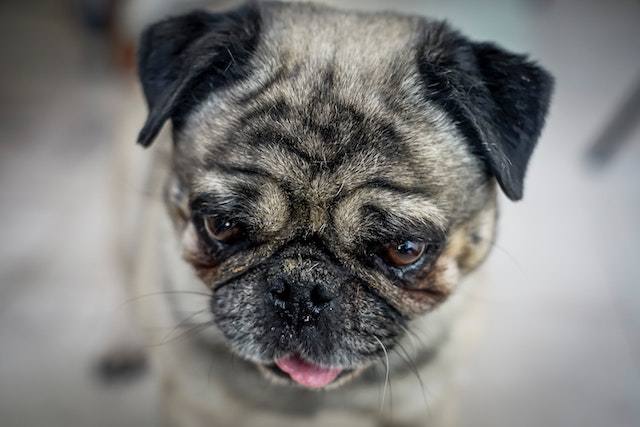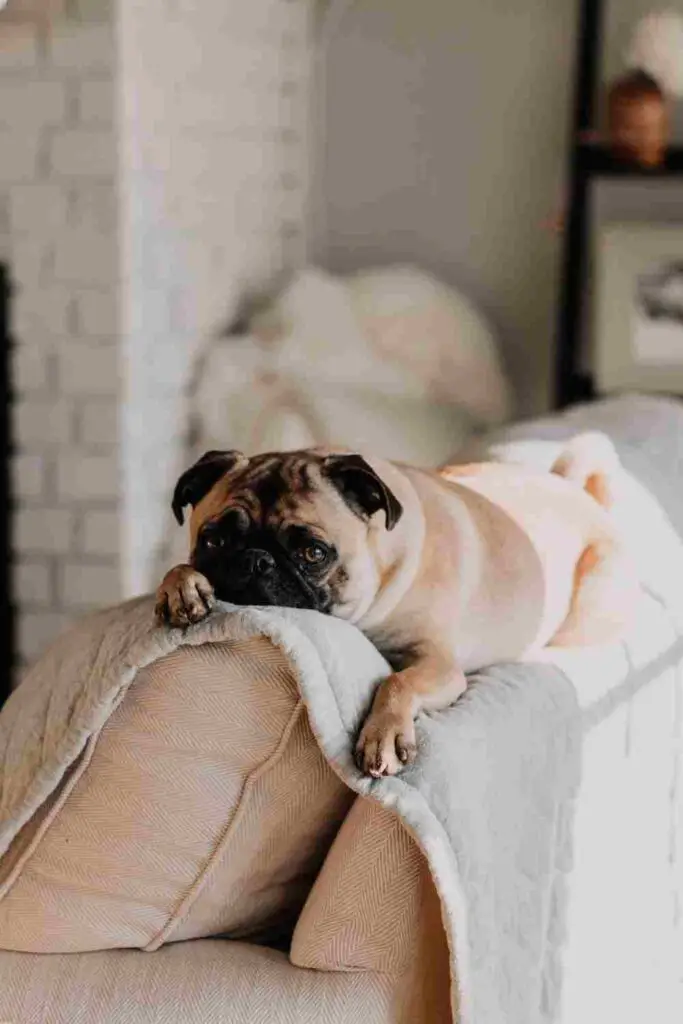Understanding and Managing Pug Allergies

Are you a proud pug parent dealing with constant sneezing and itchy eyes? Pug allergies are real, and they can affect both you and your furry friend. But don’t worry, we’ve got you covered.
In this blog post, we’ll explore everything you need to know about pug allergies, from common symptoms to effective treatments. So grab a cup of tea and let’s dive in!
What Are Pug Allergies?
Pug allergies refer to a group of allergic reactions that Pugs may experience in response to various allergens in their environment.
Some of the most common allergens include airborne allergens like pollen, dust mites, mold, and certain foods or chemicals.
Exposure to these allergens can trigger a variety of symptoms in Pugs, including itching, skin irritation, rashes, hot spots, and more.
Allergic reactions in Pugs may also manifest as respiratory issues, such as sneezing, coughing, and wheezing, though skin allergies are more common.
Signs of Pug Allergies

Pugs, like any other breed of dog, can suffer from allergies. Here are some common signs to look for:
- Itching: Pugs with allergies often scratch and lick themselves frequently, especially around their ears, paws, armpits, and groin.
- Redness: Allergic reactions can cause redness and inflammation on a pug’s skin.
- Hot spots: Constant scratching and licking can lead to hot spots or moist, infected skin lesions.
- Ear infections: Due to their floppy ears and narrow ear canals, pugs are prone to ear infections caused by allergies.
- Runny eyes: Allergies can cause a pug’s eyes to water or become red and irritated.
- Coughing and sneezing: Allergies can trigger respiratory symptoms such as coughing, wheezing, or sneezing in pugs.
- Digestive issues: Some pugs may experience vomiting, diarrhea, or gassiness due to food allergies.
- Lethargy: Allergies can make a pug feel lethargic and less playful than usual.
- Behavioral changes: In some cases, allergies may cause a pug to be more irritable, restless, or anxious than normal.
Causes of Allergies in Pugs
Allergies are a common health issue for Pugs. There are various causes of allergies that can affect a Pug, which include:
1. Pollen Allergies
Pugs can develop allergies to pollen from trees, grass, and flowers. If a Pug is allergic to pollen, they may exhibit symptoms such as itchy skin, redness, inflammation, and sneezing.
2. Food Allergies
Food allergies are another common cause of allergies in Pugs. Some common allergies-causing foods for Pugs include beef, chicken, soy, wheat, corn, and dairy products. Symptoms of food allergies may include vomiting, diarrhea, itchy skin, and paw licking.
Learn more about what foods pugs should avoid here.
3. Flea Allergies
Flea allergies cause severe itching in Pugs. Even one flea bite can trigger an allergic reaction in a Pug. If your Pug is allergic to fleas, it’s important to keep them on regular flea prevention treatment.
4. Insect Allergies
In addition to fleas, Pugs can develop allergies to other insects such as mosquitoes and ticks. Symptoms may include itchy skin, inflammation, and redness.
5. Contact Allergies
Pugs can develop contact allergies from coming into contact with certain materials such as plastic, rubber, and wool. Symptoms of contact allergies may include itchy skin, redness, and inflammation.
6. Medications
Some Pugs can develop allergies to certain medications. Common medications that can cause allergic reactions include antibiotics, painkillers, and topical ointments.
7. Household Chemicals
Pugs can develop allergies to household chemicals used for cleaning, such as bleach and detergents. Symptoms may include itchy skin, redness, and inflammation.
8. Mold and Dust Mites
Mold and dust mites can cause allergies in Pugs. Symptoms may include sneezing, itchy skin, and inflammation.
9. Other Dogs or Cats
Some Pugs may develop allergies to other dogs or cats. Symptoms may include itchy skin, sneezing, and respiratory issues.
It is important to note that Pugs can have multiple allergies at once, and it’s crucial to contact a veterinarian if you suspect your Pug has an allergy to get a proper diagnosis and treatment plan.
Diagnosing Pug allergies

To diagnose Pug allergies, a veterinarian will usually perform one or a combination of the following tests and procedures:
- Skin test: A small amount of allergens is injected under the dog’s skin to determine which ones cause a reaction.
- Serum test: A blood test that checks for antibodies to specific allergens.
- Elimination diet: The dog is fed a hypoallergenic diet for 8-12 weeks to determine if food is the cause of the allergy.
- Intradermal test: Similar to the skin test, but instead of injecting allergens under the skin, they are injected directly into it.
It’s important to visit a veterinarian to properly diagnose Pug allergies and determine the appropriate treatment plan for the affected dog.
Each type of allergy may require different treatment methods, and in some cases, a combination of strategies may be necessary to manage the symptoms.
Pug Allergies Treatment Options
When it comes to treating allergies in Pugs, treatment may vary from dog to dog. The first step in treating allergies is identifying the allergen causing the reaction.
Some possible treatment options for Pug allergies are:
1. Symptomatic Treatment: Depending on the severity of the allergy, your veterinarian may prescribe antihistamines or corticosteroids (steroids) to block the allergic reaction and relieve itchiness and inflammation.
2. Allergen Avoidance: Avoiding exposure to allergens may be recommended. This could involve using hypoallergenic products, feeding a hypoallergenic diet, or limiting outdoor time during high-allergen seasons.
3. Immunotherapy: An allergen-specific immunotherapy treatment known as “allergy shots” may be prescribed to desensitize your Pug to a particular allergen.
4. Supportive Treatment: Supportive treatments such as medicated shampoos, topical ointments, or essential fatty acid supplements may be recommended to soothe your Pug’s skin.
Managing Pug Allergies

If you have a Pug with allergies, here are some common tips that can help you manage their symptoms:
- Identify the allergen: The first step in managing allergies is to determine what your Pug is allergic to. This can be done through allergy testing.
- Limit exposure: Once you identify the allergen, limit your Pug’s exposure to it. For example, if your Pug is allergic to dust mites, wash bedding frequently and use allergen-proof bedding covers.
- Use medication: Over-the-counter or prescription medications can help control allergy symptoms. Antihistamines, decongestants, or corticosteroids may be prescribed by your veterinarian.
- Use allergy shots: Allergy shots or immunotherapy may be recommended for dogs with severe allergies. These shots contain small amounts of the allergen and help your Pug build up immunity over time.
- Avoid irritants: Chemicals in cleaning products or air fresheners may irritate your Pug’s allergies. Avoid using these products or look for allergy-friendly alternatives.
- Bath regularly: Regular baths can help to remove dander and other allergens from your Pug’s coat, which can reduce symptoms.
- Change diet: Sometimes allergies in dogs can be due to food sensitivities or intolerances. Your veterinarian can help determine if this is the case and recommend a diet change or supplement.
- Maintain a clean house: Keep your home clean to avoid dust accumulation and other allergens. Vacuum frequently and use air filters to help maintain air quality.
- Work with your veterinarian: Your veterinarian can help you create a treatment plan for your Pug’s allergies and suggest lifestyle changes that can help manage symptoms.
Pug Allergies in Humans

Pugs can cause allergies in humans. This is because they shed heavily, and their dander can be found in the air, on surfaces, and on clothing. Pugs can also bring in outdoor allergens such as pollen and dust.
Causes of pug allergies in humans
The major cause of allergies in humans from pugs is due to their dander, saliva, and urine. If a person is allergic to these substances, they are likely to experience an allergic reaction when they come into contact.
Symptoms of pug allergies in humans
Some common symptoms of pug allergies in humans include:
- Itching
- Sneezing
- Watery and itchy eyes
- Runny nose
- Congestion
- Wheezing
- Asthma
Treatment and Prevention in Humans
The best way to manage pug allergies in humans is to limit exposure to pugs and their dander. Regular vacuuming and cleaning of surfaces can also help. In addition, using HEPA filters, and air purifiers, and washing bedding regularly can significantly reduce exposure to allergens.
For treatment, over-the-counter antihistamines such as loratadine and cetirizine can be used to alleviate symptoms.
In case of asthma or severe allergic reactions, prescription inhalers or epinephrine injections may be necessary. In any case, it is important to consult a doctor for a proper diagnosis and treatment plan.
Related Questions
Can pugs cause allergies?
Yes, pugs, like all dog breeds, can trigger allergies in some people. The common allergen is usually pet dander, which is made up of tiny flakes of skin and hair that a dog sheds.
Learn more about why pugs smell and pug shedding.
What can I do if I think I’m allergic to my pug?
If you suspect that you’re allergic to your pug, it’s important to schedule an appointment with your healthcare provider for allergy testing. Depending on the severity of your allergy symptoms, your doctor may prescribe medications, such as antihistamines, or recommend other treatments, like immunotherapy shots.
Can regular grooming help reduce pug allergies?
Yes, regular grooming, such as brushing your pug’s coat, bathing them regularly, and cleaning their bedding, can help reduce the amount of pet dander in your home, which can help lessen allergy symptoms.
Learn more about pug skin allergies and skin problems.
Are there any hypoallergenic pug breeds?
While there’s no such thing as a truly hypoallergenic dog breed, some pugs are less likely to cause allergies than others. For example, pugs with shorter hair may produce less dander than those with longer hair.
Can children be allergic to pugs?
Yes, children can be allergic to pugs, just like adults. It’s important to watch for signs of allergies in children, as their symptoms may be different than those of adults. If you suspect your child is allergic to your pug, speak with their pediatrician for advice on the best course of treatment.
Can allergies in pugs worsen with time?
Allergies can develop and worsen over time, making early detection and management crucial.
Can pugs be allergic to certain fabrics or materials?
Yes, some pugs may be sensitive to certain fabrics or materials used in bedding, clothing, or toys.
Learn more about pug sick signs.
Conclusion
So there you have it – all you need to know about pug allergies! While these cute little pups are known for their lovable and friendly personalities, it’s important to be aware of the potential allergy issues that may arise.
Whether you’re a seasoned pug owner or considering bringing one into your home, being informed and prepared is key.
Keep these tips and tricks in mind, and you and your pug will be happy, healthy, and allergy-free!
